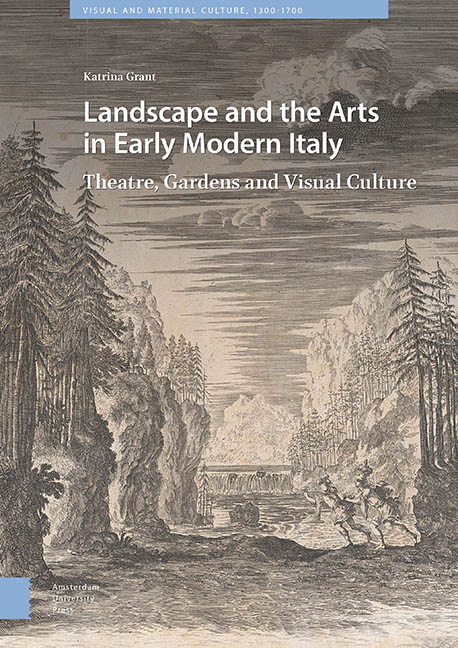Book contents
- Frontmatter
- Contents
- Acknowledgements
- Introduction
- 1 Theatricality, a View from the Landscape
- 2 Gardens of the Gods : Classical Revival, Intermedi, Early Opera and the Idea of Nature
- 3 The (Singing) Figure in the Landscape
- 4 Triumph over Nature : Machines and Meraviglia on the Seventeenthcentury Stage
- 5 The Theatre in the Landscape : Pliny to Pratolino
- 6 The Garden as Stage, the Visitor as Performer
- 7 Stages without Actors : Theatres of Sculpture, Water and Flowers
- 8 Performing in the Parrhasian Grove : Green Theatres and the Academies
- Bibliography
- Index
- Frontmatter
- Contents
- Acknowledgements
- Introduction
- 1 Theatricality, a View from the Landscape
- 2 Gardens of the Gods : Classical Revival, Intermedi, Early Opera and the Idea of Nature
- 3 The (Singing) Figure in the Landscape
- 4 Triumph over Nature : Machines and Meraviglia on the Seventeenthcentury Stage
- 5 The Theatre in the Landscape : Pliny to Pratolino
- 6 The Garden as Stage, the Visitor as Performer
- 7 Stages without Actors : Theatres of Sculpture, Water and Flowers
- 8 Performing in the Parrhasian Grove : Green Theatres and the Academies
- Bibliography
- Index
Summary
All’Atto secondo un’improvisa mutatione della Scena, che di grotta si vidde a un tratto rappresentare l’Isola disabitata di Magistea, nido horrendo della Chimera; Boscareccia era l’apparenza, e qualche fabrica, che pur si vedeva per entro rovinosa, e disfatta, erano però quelle rovine dilettevoli alla vista come piene d’arte eccelente, […] gl’alberi si vedevano con somma diligenza intagliati […] Ondeggiava in faccia un gran mare turbato.
The Second Act began with an unexpected change of Scene, a cave suddenly appeared to represent the uninhabited island of Magistea, the horrendous nest of the Chimera; A woodland could be seen, and some of the buildings, which, although they were ruined and destroyed, still delighted the eye with the excellence of their art […] the trees that could be see had been carved with great diligence […] in front was a great and turbulent sea – Bellerofonte, 1642
These words from the libretto of the opera Bellerofonte conjure up a vision of a longlost scene from the Venetian stage. The landscape is both delightful and horrendous, it shows great art in its design and takes the eye across a landscape. This theatrical, or scenographic landscape, is just one of many that were staged for audiences in the seventeenth century. Written descriptions tell us of the ‘meraviglia’ or wonders that captured the eye and the feelings of delight and horror they elicited in the audience. They speak of the illusion of naturalness of the scenes and amazement at the mimicry of the natural effects of clouds, lightning and thunder brought inside. The seventeenth century was a time when the relationship between humans and nature shifted. In art this new fascination with nature saw the rise of the genre of landscape painting. In gardens architects introduced monumental structures designed to overwhelm spectators, which were contrasted with smaller, intimate spaces designed for retreat. At the same time engineers revived ancient techniques and built upon them to realize new ways to control and reshape the landscape and put these techniques to work in gardens.
- Type
- Chapter
- Information
- Landscape and the Arts in Early Modern ItalyTheatre, Gardens and Visual Culture, pp. 9 - 16Publisher: Amsterdam University PressPrint publication year: 2022

